Hello everyone, I hope you are well ☺️ I already shared a post where I talked about the interior of the incredible space museum in Toulouse, highlighting some of the exhibits that impressed me most. Today, I will continue talking about this fascinating museum and finish showing more details of this beautiful space. Every corner of the museum has something special to discover, from its interactive exhibits to the details that make us dream about the future of space exploration. It's a place worth exploring from start to finish, and I look forward to sharing more conversation!
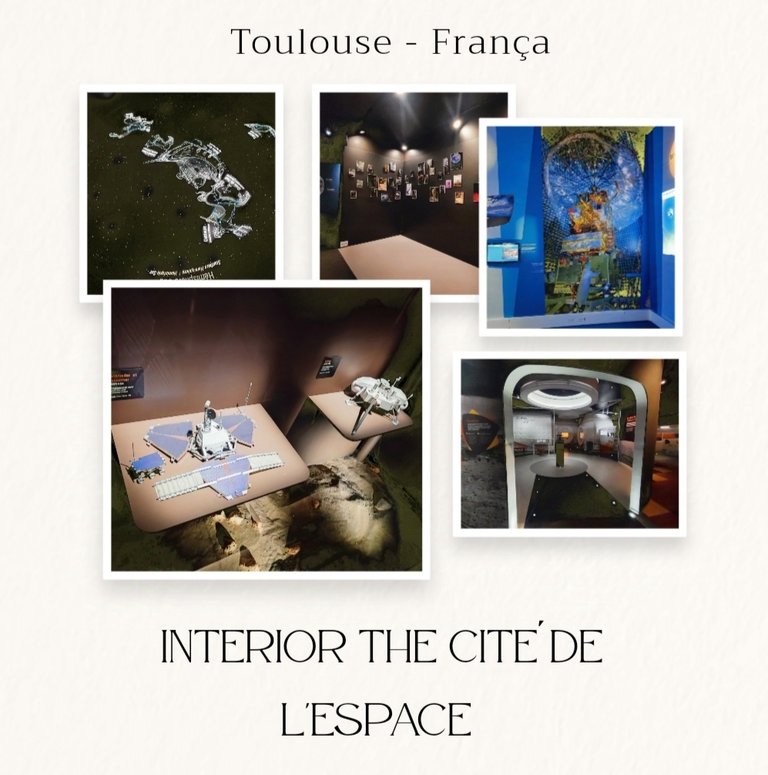
The museum has a modern entrance, with a circular ceiling that resembles planets in orbit. As soon as you arrive, there are digital panels that probably show information about the exhibitions and schedules. The environment seems to be very technological and welcoming, perfect for those who want to learn more about the space. This initial space makes a good impression and it seems that the museum is investing in technology to engage visitors. It is a place that promises an interactive experience from the beginning, preparing those who arrive to explore the rest of the museum in a fun and educational way.
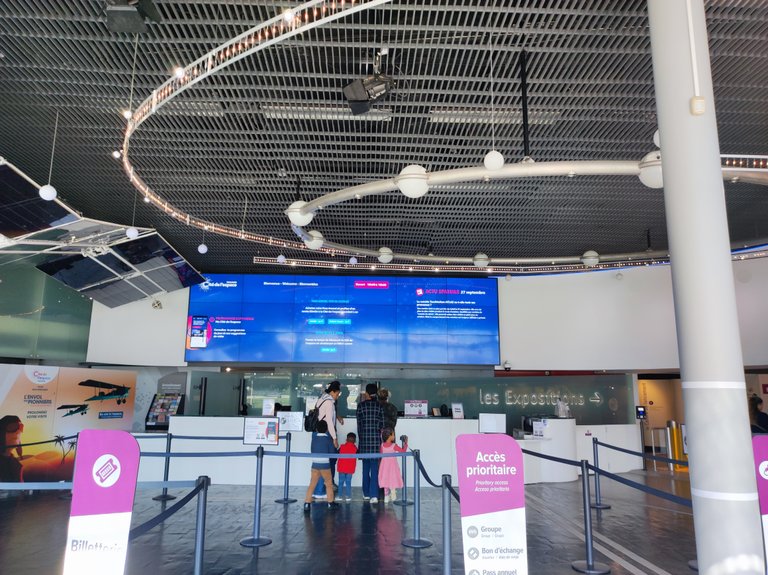
Rockets of different sizes are on display, showing the models used to launch satellites into space. In addition to them, there is a map showing the location of Kourou, an important location for space launches. These rockets help us understand how technology has evolved over the years and how these missions are essential for discovering more about the universe. Seeing the rockets up close allows visitors to understand the importance of these missions and how they impact our knowledge of space today.
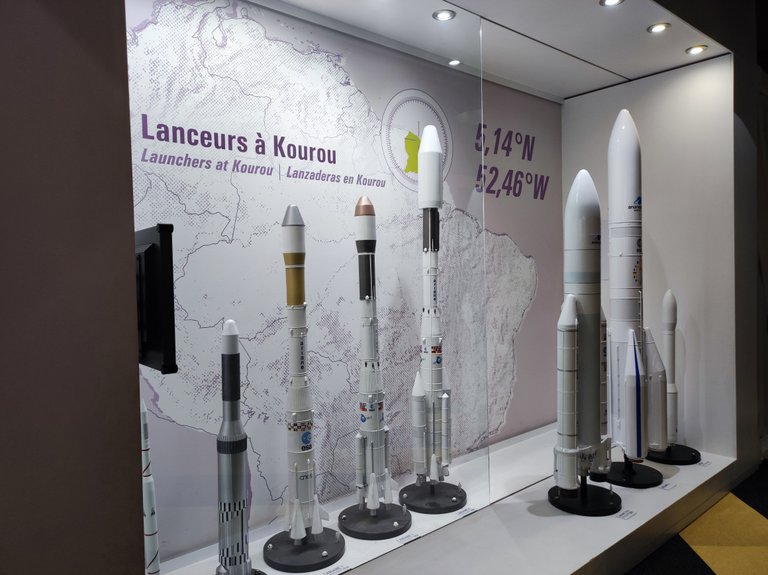
A large display shows a satellite or probe in detail, floating in space. The blue background highlights the advanced technology that is used in these space missions. Nearby, there are monitors that probably explained more about how this equipment works and what it does in space. This part of the exhibition brings visitors closer to the reality of space exploration and the importance of these devices. The presentation helps to better understand how man uses these machines to learn more about the universe and send information to Earth.
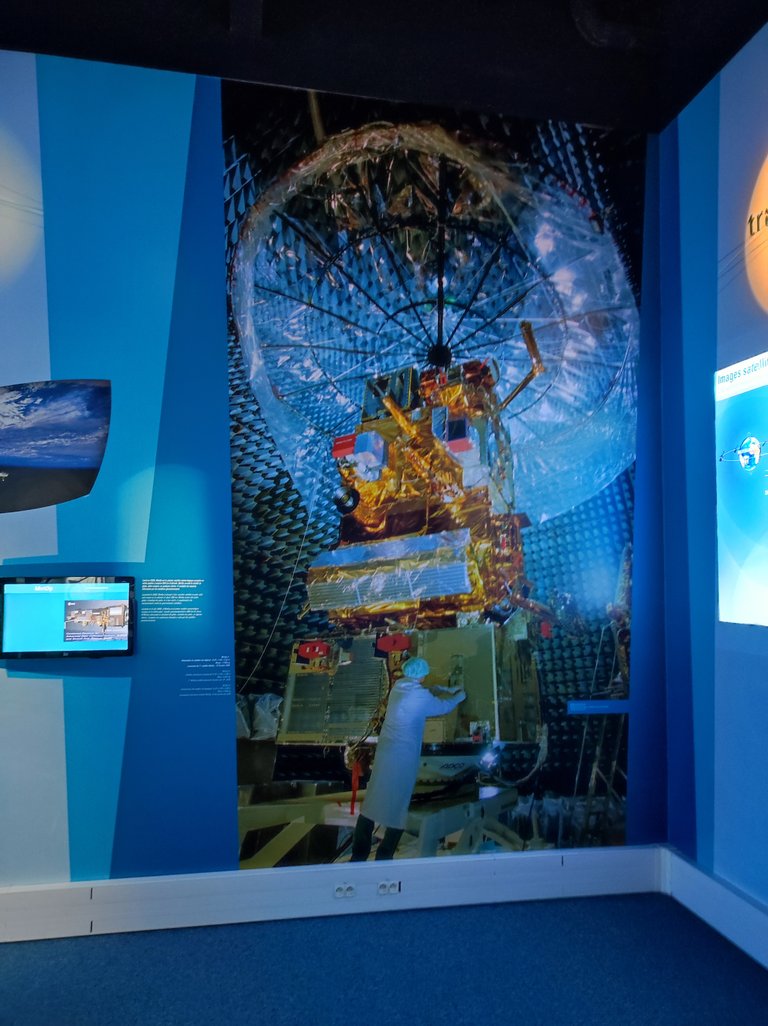
The museum has a hallway that looks very futuristic, with white arches and projections on the walls. The projected images show landscapes and scenes related to space. This corridor makes the visit more interesting as visitors can learn about the space in an interactive and visual way. The environment is very modern and invites those who come to explore more about the topic in an engaging way. It seems like a good way to learn while walking through the museum, with a visual experience that helps you better understand what is being displayed.
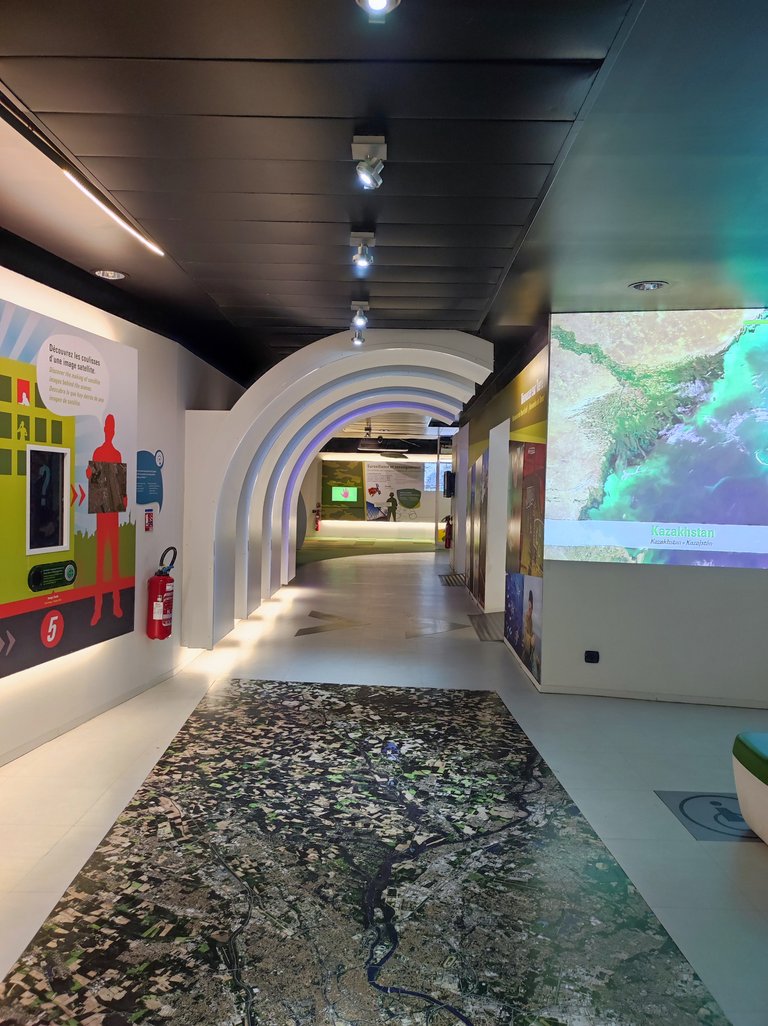
In this exhibit, we see small models of robots and probes that were likely used on space missions. They are interested in small tables, and there is direct lighting on each, highlighting the details. The environment seems very dark, which makes the models attract even more attention. These types of robots are used to explore the surface of other planets, collecting important data and information for scientists. This space offers an up-close view of these technologies, allowing visitors to understand how these devices work in unfamiliar environments.

This image shows an exhibit that focuses on lunar missions. In the center, there is a large circle that highlights the interior of a spaceship, with space in the background. The scene recreates the lunar surface with a probe in the foreground, bringing to mind the historical moments of the missions that reached the Moon. This immersive environment makes visitors feel part of space missions, showing how explorations are conducted. It's a way to connect people to the history of space conquests in a visual and interactive way.
In this room, there are several images suspended on the walls, probably showing astronauts, equipment or memorable moments from space missions. The environment is dark, with lights focused on the images, which creates an atmosphere of reflection. Visitors can walk around the room and look at these photos, learning about different parts of the missions and the challenges faced in space. This type of exhibit helps bring to life the stories behind space exploration by highlighting the people, events and equipment that made these achievements possible.

The last space shows a futuristic area, with a rounded design and soft lighting, perhaps a room dedicated to presentations or interactive videos. The path takes the visitor to the center, where there may be an important exhibition or an explanatory film about space exploration. The modern and well-lit environment makes this space very engaging. This structure, with circular shapes and specific lighting, is ideal for keeping visitors' attention while they learn more about the space and the technologies used in missions over the years.
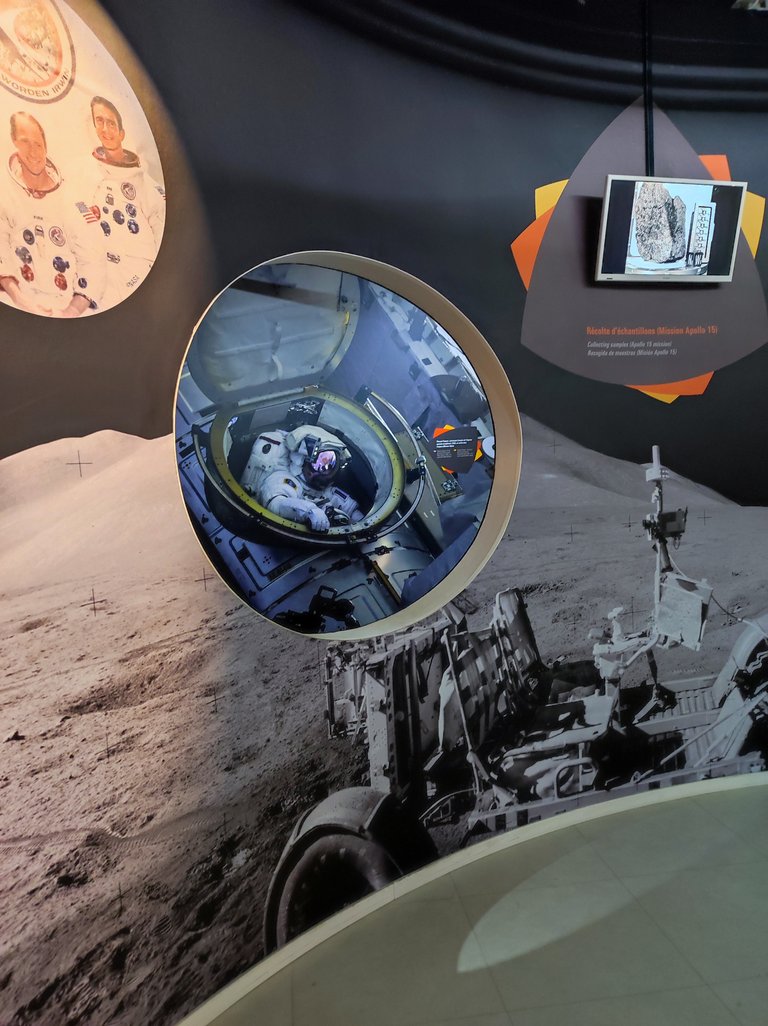
we see a dark area with several white geodesic structures. The domes appear to simulate futuristic environments or even space bases, where visitors can explore different exhibits. The soft lighting inside the domes creates a mysterious atmosphere, encouraging curiosity about what is inside each of them. This type of structure also refers to habitats that could be used on planets like Mars, offering a vision of what it would be like to live in an extraterrestrial environment. The environment invites visitors to delve into the possibilities of space exploration.
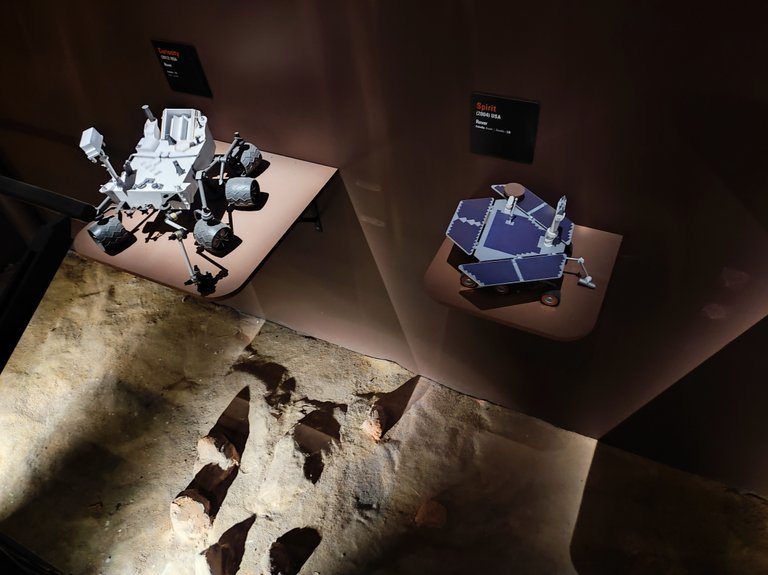

we observe a projection of the sky with the constellations drawn and highlighted. Each of the figures is illuminated, helping to identify the shapes that, over the centuries, people have imagined in the stars. This exhibit helps visitors learn more about astronomy and the history of the constellations by showing how ancient cultures used the stars for navigation and mythmaking. The experience is immersive and educational, making it easier to understand how constellations are formed and the important role they played in different civilizations throughout history.
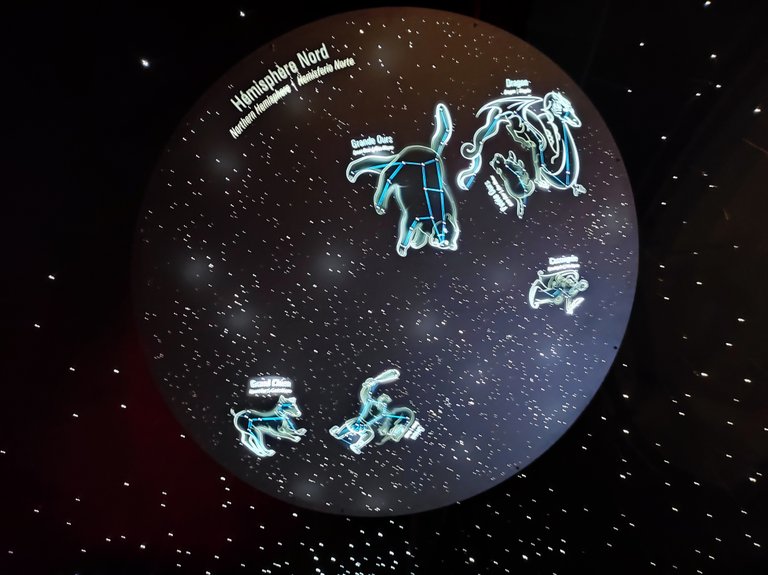
I hope you liked it, see you soon friends 😃
Olá a todos, espero que estejam bem ☺️ Já partilhei um post onde falei sobre o interior do incrível museu espacial de Toulouse, destacando algumas das exposições que mais me impressionaram. Hoje continuarei falando sobre esse fascinante museu e terminarei mostrando mais detalhes desse lindo espaço. Cada canto do museu tem algo especial para descobrir, desde as exposições interativas até aos detalhes que nos fazem sonhar com o futuro da exploração espacial. É um lugar que vale a pena explorar do início ao fim e estou ansioso para compartilhar mais conversas!

O museu tem entrada moderna, com teto circular que lembra planetas em órbita. Assim que você chega, há painéis digitais que provavelmente mostram informações sobre as exposições e horários. O ambiente parece ser bastante tecnológico e acolhedor, perfeito para quem quer conhecer mais sobre o espaço. Esse espaço inicial causa boa impressão e parece que o museu está investindo em tecnologia para engajar os visitantes. É um local que promete uma experiência interativa desde o início, preparando quem chega para explorar o resto do museu de forma divertida e educativa.

Foguetes de diversos tamanhos estão em exposição, mostrando os modelos usados para lançar satélites ao espaço. Além deles, há um mapa que mostra a localização de Kourou, importante local para lançamentos espaciais. Esses foguetes nos ajudam a entender como a tecnologia evoluiu ao longo dos anos e como essas missões são essenciais para descobrir mais sobre o universo. Ver os foguetes de perto permite que os visitantes entendam a importância dessas missões e como elas impactam nosso conhecimento do espaço hoje.

Um grande display mostra em detalhes um satélite ou sonda flutuando no espaço. O fundo azul destaca a tecnologia avançada usada nessas missões espaciais. Nas proximidades, existem monitores que provavelmente explicaram mais sobre como funciona este equipamento e o que faz no espaço. Esta parte da exposição aproxima os visitantes da realidade da exploração espacial e da importância destes dispositivos. A apresentação ajuda a entender melhor como o homem utiliza essas máquinas para aprender mais sobre o universo e enviar informações para a Terra.

O museu tem um corredor que parece bem futurista, com arcos brancos e projeções nas paredes. As imagens projetadas mostram paisagens e cenas relacionadas ao espaço. Este corredor torna a visita mais interessante, pois os visitantes podem conhecer o espaço de forma interativa e visual. O ambiente é bastante moderno e convida quem vem a explorar mais sobre o tema de forma envolvente. Parece uma boa forma de aprender caminhando pelo museu, com uma experiência visual que ajuda a entender melhor o que está sendo exposto.

Nesta exposição, vemos pequenos modelos de robôs e sondas que provavelmente foram usados em missões espaciais. Eles se interessam por mesas pequenas, e há iluminação direta em cada uma, destacando os detalhes. O ambiente parece muito escuro, o que faz com que os modelos atraiam ainda mais atenção. Esses tipos de robôs são usados para explorar a superfície de outros planetas, coletando dados e informações importantes para os cientistas. Este espaço oferece uma visão de perto destas tecnologias, permitindo aos visitantes compreender como estes dispositivos funcionam em ambientes desconhecidos.

Esta imagem mostra uma exposição focada em missões lunares. No centro, há um grande círculo que destaca o interior de uma nave espacial, com espaço ao fundo. A cena recria a superfície lunar com uma sonda em primeiro plano, trazendo à memória os momentos históricos das missões que chegaram à Lua. Esse ambiente imersivo faz com que os visitantes se sintam parte das missões espaciais, mostrando como são conduzidas as explorações. É uma forma de conectar as pessoas à história das conquistas espaciais de forma visual e interativa.
Nesta sala encontram-se diversas imagens suspensas nas paredes, provavelmente mostrando astronautas, equipamentos ou momentos memoráveis de missões espaciais. O ambiente é escuro, com luzes focadas nas imagens, o que cria uma atmosfera de reflexão. Os visitantes podem passear pela sala e ver essas fotos, conhecendo diferentes partes das missões e os desafios enfrentados no espaço. Este tipo de exposição ajuda a dar vida às histórias por trás da exploração espacial, destacando as pessoas, eventos e equipamentos que tornaram possíveis essas conquistas.

O último espaço apresenta uma área futurista, com design arredondado e iluminação suave, talvez uma sala dedicada a apresentações ou vídeos interativos. O caminho leva o visitante ao centro, onde poderá haver uma importante exposição ou um filme explicativo sobre a exploração espacial. O ambiente moderno e bem iluminado torna este espaço muito envolvente. Essa estrutura, com formatos circulares e iluminação específica, é ideal para manter a atenção dos visitantes enquanto eles aprendem mais sobre o espaço e as tecnologias utilizadas nas missões ao longo dos anos.

vemos uma área escura com diversas estruturas geodésicas brancas. As cúpulas parecem simular ambientes futuristas ou mesmo bases espaciais, onde os visitantes podem explorar diferentes exposições. A iluminação suave no interior das cúpulas cria uma atmosfera misteriosa, estimulando a curiosidade sobre o que há dentro de cada uma delas. Esse tipo de estrutura também se refere a habitats que poderiam ser utilizados em planetas como Marte, oferecendo uma visão de como seria viver em um ambiente extraterrestre. O ambiente convida os visitantes a mergulhar nas possibilidades de exploração do espaço.


observamos uma projeção do céu com as constelações desenhadas e destacadas. Cada uma das figuras é iluminada, ajudando a identificar as formas que, ao longo dos séculos, as pessoas imaginaram nas estrelas. Esta exposição ajuda os visitantes a aprender mais sobre astronomia e a história das constelações, mostrando como as culturas antigas usavam as estrelas para navegação e criação de mitos. A experiência é imersiva e educativa, facilitando a compreensão de como as constelações se formam e o importante papel que desempenharam nas diferentes civilizações ao longo da história.

Espero que tenham gostado, até breve amigos 😃


